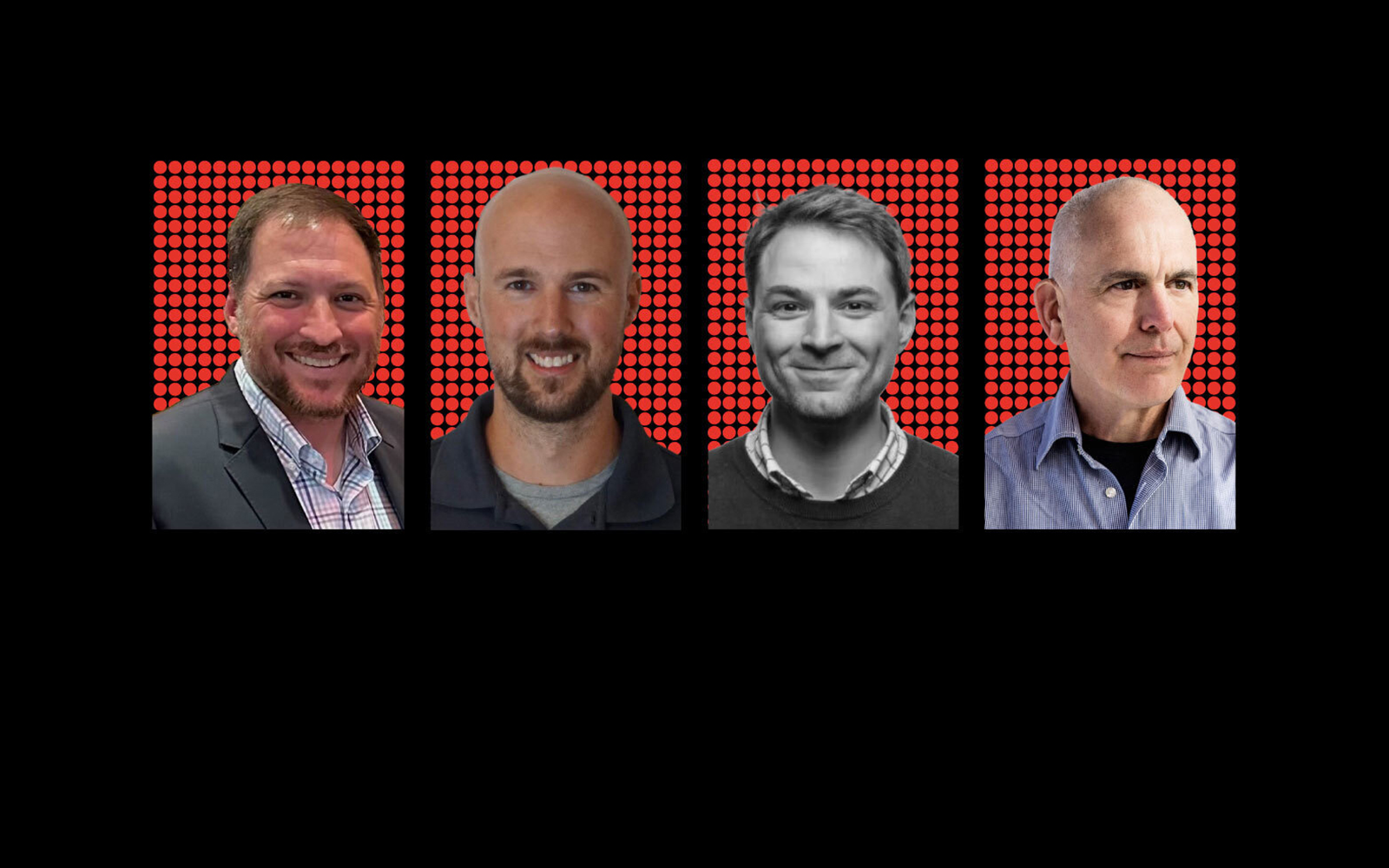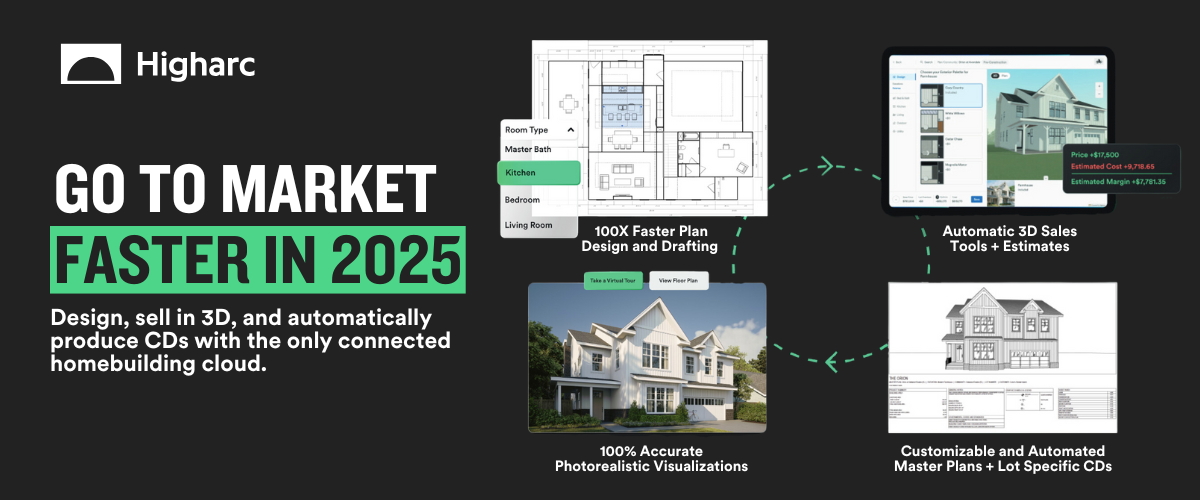Architecture
When Homebuyers Freeze, Homebuilders Must Build Their Machine
New-home demand is sputtering as buyers second-guess timing, costs, and rates. Our upcoming webinar with Signature Homes and Higharc explores how builders can reset the rules with customer-first systems.

[Image IDs, from left: Tyler Belcher, Executive VP, Signature Homes, Kyle Bear, VP Research & Development, Signature Homes, Marc Minor, Co-Founder, CEO, Higharc, and John McManus, The Builder's Daily]
The American new-home market looks and feels like it’s trying to run in ankle-deep mud.
Sales are happening, but every deal feels harder to land than the last. Mortgage rates hover near cycle highs. Home prices remain sticky at levels beyond both beliefs and pocketbooks. And many households are doing the math this way: if rates and prices are both expected to fall later this year, why lock into today’s number?
That suspicion — that buying now is foolish — is spreading. For homebuilders, that’s the most dangerous force in the market: indecision.
So, what do you do when your business depends on a predictable pace, but the buyer you need most is frozen in place?
That’s the context framework for How Outlier Homebuilders Win, our live The Builder’s Daily – which you can click to access on-demand – featuring operational leaders from Signature Homes and technology platform Higharc.
On-Demand access: How Outlier Homebuilders Win.

The Context: A Sputtering Market
Through midsummer, new-home demand may have found some footing. Then came another lurch: traffic softened, cancellations ticked up, and incentives crept higher.
Builder confidence just slipped again. The NAHB/Wells Fargo Housing Market Index for August printed 32, down a point from July and stuck in a 16-month run of negative readings. Buyer traffic nudged up to 22 but remains “very low,” while the index of current sales fell to 35 and six-month expectations held at 43. The market’s message is plain: elevated mortgage rates, weak traffic, and persistent supply frictions are dragging sentiment sideways. Price cuts held at 37% of builders (average reduction 5%), and the use of sales incentives climbed to 66%, the highest share in the post-COVID period. Regionally, three-month averages ticked to 44 (Northeast), 42 (Midwest), 29 (South), and 24 (West).
That’s the headwind our audience will bring into Wednesday’s live conversation: a market that rewards activity, not complacency, and punishes indecision. The issue we need to underline is that organizations must not wait to make hard decisions, solve hard problems, and pivot through hard challenges to synchronize operations—people, tech, and process—around the homebuyer’s needs, means, and motivations.
Pace Over Profit, Revisited
The strategic translation: private operators are consciously trading margin for momentum—positioning for the turn by keeping pace, preserving trade relationships, opening communities, and recycling cash. In The Builder's Daily contributor Scott Cox’s terms, publics have largely abandoned “pricing to margin” in favor of pricing to velocity; private builders who ignore those market signals risk period-cost creep, stalled cash flow, eroding lender confidence, and lost share. Stall speed is fatal. Houses should never have a birthday.
Meanwhile, traditional AD&C lending has tightened, with many regional banks reducing or exiting programs. Private debt has stepped in—often at shorter maturities with tighter monitoring—but for builders committed to pace, that’s a workable trade versus no financing at all.
The Outlier Pattern: Signature x Higharc
Against that macro, Wednesday’s webinar looks at a concrete, repeatable pattern we’re seeing among outliers: unify product, pricing, marketing, sales, estimating, and field execution around a single source of truth; compress the time from concept to start; and give buyers more real, controllable choice without blowing up cost or cycle.
Signature Homes EVP Tyler Belcher will set the scene:
“The market is tougher now… mortgage rates are persistently high. There’s a lot of policy uncertainty… there are less buyers to go around. Costs are higher and land costs are higher post-covid. That means we have to have great product, and we have to show that product, right?”
Then he’ll connect it to the firm’s operational pivot:
Now we have a single source of truth… We can manage more options where, in the past, we’d have to make a decision about when it got too complex. Our original version of the Signature Series started at a much higher price. Now we’re going to start much lower and option to scale it up… and the huge time savings… about 10% of the time compared to what it was taking us for the same amount of work.”
Belcher adds a velocity KPI that matters when confidence is shaky:
Our inventory turn has not gone down… we can add more complexity and keep our same schedule—running a 100-day schedule—for homes averaging over a million bucks.”
VP of R&D Kyle Bear explains how they got there—by removing structural complexity from the system and giving buyers choice inside constraints:
We reached a point where we had to break our efficiencies. We’d have two versions of the same plan so that we could control the options; sometimes, we ended up with three. Now it’s all built into one, and we can make faster changes a lot easier. It gives us the ability to execute them better.”
That simplification shows up in the front-end experience too:
It’s going to streamline it for our buyers… instead of a Cantor, a Cantor Executive, and a Grand Cantor that look the same at first glance, it’s one plan. That’s clearer for sales, clearer for buyers, and it reduces errors that come from outdated collateral.”
Compression is the second lever. Bear again:
Having the ability to turn something from a napkin sketch to starting framing in 90 days—you can’t do that without leverage.”
On whether the end product still feels “production,” Bear is blunt:
If you stuck this on a lot in another city where people didn’t know Signature, they would think it’s a custom home… it feels custom, looks custom.”
The Tech Angle, Without the Hype
Higharc CEO Marc Minor situates this in a larger industry shift:
We’re part of a shift happening industry-wide toward leveraging technology to reduce overhead and go faster… If we continue with disintegrated systems—really old pieces of software that don’t work well together—that puts all the pressure back on humans to pass paper around.”
On cost discipline and pricing accuracy:
Make a change. Know how much it costs. Make a change. Know how much it costs you, the builder; know how much it’s going to cost the buyer.”
Signature is already pressing those edges. Bear:
We will push the limits of the software we have available to us.”
That includes constraint-based “modifier” logic—think garage-depth adjustments in one-foot increments tied to zoning or driveway criteria—that used to chew up hours of bespoke drafting time:
We set it up where we could do our modifiers by any length we want… In Revit it would take us three or four hours.”
And it includes real-time estimating that prevents the most painful surprise of all:
Nothing’s worse than your first one—the first time it sells—and you go to build it, and you’re like, ‘Wait, how am I losing money on this option?’”
Finally, a portfolio-level simplification move that matters for SG&A and speed:
We cut down our number of plans we’re managing by a third, and actually have more product offering.” — Belcher
What Attendees Will See
Beyond the talk, the team plans to screen-share live models—like Signature’s “Patterson”— to illustrate how a single data model powers marketing-grade visualization, sales configuration, options governance, estimating, and site-fit in one place. Expect a quick peel-away to framing view to show how dimensional precision flows into takeoffs and POs, and how site-grading logic (e.g., driveway at 2% slope in one-inch increments every four feet) rolls up into buildable reality. The goal isn’t to demo software; it’s to show leaders how a unified system removes the friction that kills velocity when confidence is fragile.
Why This Matters Now
Put the pieces together:
- Confidence is low (HMI 32) and incentives are high (66%).
- Orders can move when you meet the market, but margins compress.
- Liquidity is precious, and traditional bank credit is tight.
- Publics are already optimized for velocity.
For private operators, the risk of waiting for clarity is bigger than the cost of building the machine now. That means:
- Meet the market on price and terms early (smart incentives, not blanket giveaways).
- Standardize options inside constraints so buyers get visible, valuable choice you can build repeatedly.
- Collapse handoffs—one source of truth from plan to lot-fit to estimate to PO to field.
- Protect cycle and inventory turn over vanity margins; recycle cash, keep trades busy, and stay visible.
Wednesday’s conversation is built for leaders making those calls in real time. As Minor puts it, the last seven years have been “pretty crazy,” and the point isn’t prediction—it’s responsiveness. Or, in Belcher’s shorthand: have a great product, show that product, and keep it moving.
MORE IN Architecture
Car-Free, Heat-Smart, People-First: Culdesac’s Bold Model
Architect Daniel Parolek and Opticos Design answered with Culdesac Tempe, the nation’s first purpose-built, car-free community. With shade-rich design, missing middle housing, and a self-sustaining mix of homes and businesses, it’s a climate-conscious model now scaling to nearby Mesa.
How A Gamble On Floor Plans Can Be a Win for Homebuilders
If done right, floor plans can remove uncertainty for homebuyers and help builders close the sale. My top advice: Keep things simple, and make sure your teams understand how to read plans.
How Tim O’Brien Homes Is Re-Wiring Its Buyers' Experience
In a market defined by hesitation, speed and certainty separate survivors from stragglers. Tim O’Brien Homes shows how technology can deliver both.


